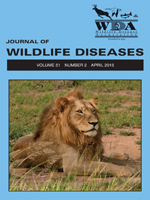If a parasite is not detected during a survey, one of two explanations is possible: the parasite was truly absent or it was present but not detected. We fit occupancy models to account for imperfect detection when combing fleas (Siphonaptera) from black-tailed prairie dogs (Cynomys ludovicianus) during June–August 2012 in the Vermejo Park Ranch, New Mexico, USA. With the use of detection histories from combing events during monthly trapping sessions, we fit occupancy models for two flea species: Oropsylla hirusta (a prairie dog specialist) and Pulex simulans (a generalist). Detection probability was <100% for both species and about 21% lower for P. simulans. Pulex simulans may be especially difficult to detect because it is about half the size of O. hirusta. Monthly occupancy (prevalence) for P. simulans was estimated at 24% (June, 95% confidence interval = 19–30), 39% (July, 32–47), and 56% (August, 49–64) in new prairie dog colonies, and 43% (32–54), 61% (49–71), and 79% (70–87) in old colonies. These results suggest P. simulans can attain high prevalence on prairie dogs, especially in old colonies. If P. simulans is highly prevalent on prairie dogs, it may serve as a “bridge vector” between Cynomys and other mammalian hosts of the plague bacterium Yersinia pestis, and even function as a reservoir of Y. pestis between outbreaks.
How to translate text using browser tools
1 April 2015
Prevalence of the Generalist Flea Pulex simulans on Black-tailed Prairie Dogs (Cynomys ludovicianus) in New Mexico, USA: The Importance of Considering Imperfect Detection
David A. Eads,
Dean E. Biggins,
Michael F. Antolin,
Dustin H. Long,
Kathryn P. Huyvaert,
Kenneth L. Gage
ACCESS THE FULL ARTICLE

Journal of Wildlife Diseases
Vol. 51 • No. 2
April 2015
Vol. 51 • No. 2
April 2015
Cynomys
flea
occupancy modeling
Oropsylla hirsuta
plague
Pulex simulans
vector





